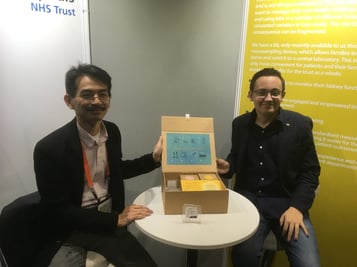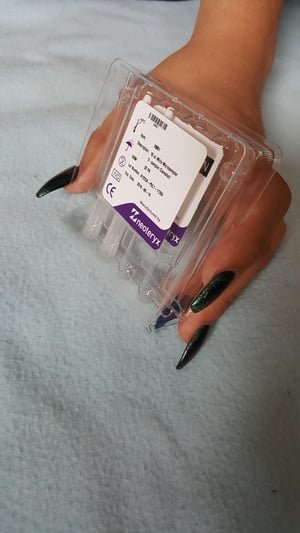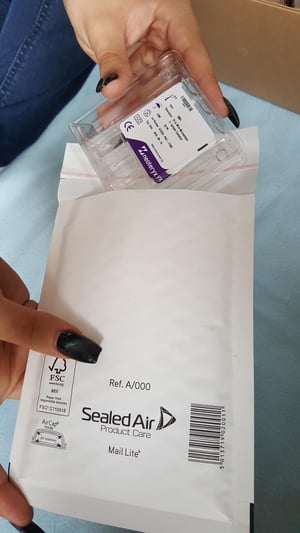Share this
how microsampling can improve life for organ transplant patients
by Neoteryx Microsampling on Nov 15, 2018 1:15:00 AM
 Quantitative, volumetrically accurate blood microsampling technology is an indisputable boon for scientists, researchers, and the entire field of health and wellness. And it also makes life easier for organ transplant patients and their families. The experience of one family in England illustrates how.
Quantitative, volumetrically accurate blood microsampling technology is an indisputable boon for scientists, researchers, and the entire field of health and wellness. And it also makes life easier for organ transplant patients and their families. The experience of one family in England illustrates how.
Caroline Knapp is a single mother living in England, away from major cities. Two years ago, when her 14-year-old son Josh (seen in photo, right) received a surprise diagnosis of ESRF, her family’s life rapidly changed.
“We didn’t really have time to digest his illness – the wait was so quick, it was kind of a whirlwind,” Caroline says. “To start with, lots of blood tests were quite a strain, to get the correct level of immunosuppressant. We live quite far from the transplant unit.”
 Fortunately, she discovered a blood collection breakthrough that lessened these visits, reducing her stress and keeping her family closer together, better able to process their experience. She encountered a home health initiative created by Monique Burgen, specialist nurse, and Jon Jin (JJ) Kim (seen in top photo at left), pediatric nephrologist, at Nottingham University Hospital.
Fortunately, she discovered a blood collection breakthrough that lessened these visits, reducing her stress and keeping her family closer together, better able to process their experience. She encountered a home health initiative created by Monique Burgen, specialist nurse, and Jon Jin (JJ) Kim (seen in top photo at left), pediatric nephrologist, at Nottingham University Hospital.
Through the initiative, she received take-home kits designed to facilitate easier therapeutic drug monitoring of tacrolimus and creatinine. Made specifically for pediatric transplant patients, the kits include all the materials needed to collect a blood sample at home, with fun bonus elements such as “finger-pricking good” lancets and “well done” stickers for successful collections.
“During a routine clinic appointment,” Caroline says, “we were told about the whole home health initiative and the Mitra® microsampling device, how it works, and how to use it. We were asked if we would like to try it. Josh, of course, being the typical 14-year-old, with the prospect of trying something totally new that could lessen hospital visits and make blood sampling a lot easier, jumped at the chance.”
Like any tech-savvy teenager, Josh learned to correctly use the Mitra devices right away. Now, remote sampling saves him time in the clinic, which he spends with his family, pursuing his education, and preparing for his future.
 Pediatric microsampling has made Caroline’s life easier, too. “We can now sit at home and do a sample using the device, send it off, and get an accurate result without having to leave the comfort of our own home – no driving for miles for blood tests.” Without remote sampling, Josh’s transplant unit would be a 108-mile round trip. “It’s a lot less stressful, plus we don’t need to take a whole day out just to go for a blood test or clinic visit, which makes school attendance better.”
Pediatric microsampling has made Caroline’s life easier, too. “We can now sit at home and do a sample using the device, send it off, and get an accurate result without having to leave the comfort of our own home – no driving for miles for blood tests.” Without remote sampling, Josh’s transplant unit would be a 108-mile round trip. “It’s a lot less stressful, plus we don’t need to take a whole day out just to go for a blood test or clinic visit, which makes school attendance better.”
Through it all, Caroline and Josh maintain their curious, optimistic outlook. "Transplants offer a whole new lease on life," says Caroline. “Josh has thrived since his transplant. He’s attended the transplant games twice and brought home medals. Technology is moving quickly – new advances and testing devices are becoming more readily available. Never be afraid to ask questions. The more you ask, the more you understand. The more you understand, the more you can explain to others. Knowledge is power. Always be honest and open with your kids and enjoy every moment."

Share this
- Microsampling (206)
- Research, Remote Research (119)
- Venipuncture Alternative (105)
- Clinical Trials, Clinical Research (83)
- Mitra® Device (73)
- Therapeutic Drug Monitoring, TDM (51)
- Dried Blood Spot, DBS (39)
- Biomonitoring, Health, Wellness (30)
- Infectious Disease, Vaccines, COVID-19 (24)
- Blood Microsampling, Serology (23)
- Omics, Multi-Omics (21)
- Decentralized Clinical Trial (DCT) (20)
- Specimen Collection (18)
- Toxicology, Doping, Drug/Alcohol Monitoring, PEth (17)
- Skin Microsampling, Microbiopsy (14)
- hemaPEN® Device (13)
- Preclinical Research, Animal Studies (12)
- Pharmaceuticals, Drug Development (9)
- Harpera Device (7)
- Industry News, Microsampling News (5)
- Antibodies, MAbs (3)
- Company Press Release, Product Press Release (3)
- Environmental Toxins, Exposures (1)
- July 2025 (1)
- May 2025 (1)
- April 2025 (2)
- December 2024 (2)
- November 2024 (1)
- October 2024 (3)
- September 2024 (1)
- June 2024 (1)
- May 2024 (1)
- April 2024 (4)
- March 2024 (1)
- February 2024 (2)
- January 2024 (4)
- December 2023 (3)
- November 2023 (3)
- October 2023 (3)
- September 2023 (3)
- July 2023 (3)
- June 2023 (2)
- April 2023 (2)
- March 2023 (2)
- February 2023 (2)
- January 2023 (3)
- December 2022 (2)
- November 2022 (3)
- October 2022 (4)
- September 2022 (3)
- August 2022 (5)
- July 2022 (2)
- June 2022 (2)
- May 2022 (4)
- April 2022 (3)
- March 2022 (3)
- February 2022 (4)
- January 2022 (5)
- December 2021 (3)
- November 2021 (5)
- October 2021 (3)
- September 2021 (3)
- August 2021 (4)
- July 2021 (4)
- June 2021 (4)
- May 2021 (4)
- April 2021 (3)
- March 2021 (5)
- February 2021 (4)
- January 2021 (4)
- December 2020 (3)
- November 2020 (5)
- October 2020 (4)
- September 2020 (3)
- August 2020 (3)
- July 2020 (6)
- June 2020 (4)
- May 2020 (4)
- April 2020 (3)
- March 2020 (6)
- February 2020 (3)
- January 2020 (4)
- December 2019 (5)
- November 2019 (4)
- October 2019 (2)
- September 2019 (4)
- August 2019 (4)
- July 2019 (3)
- June 2019 (7)
- May 2019 (6)
- April 2019 (5)
- March 2019 (6)
- February 2019 (5)
- January 2019 (8)
- December 2018 (3)
- November 2018 (4)
- October 2018 (7)
- September 2018 (6)
- August 2018 (5)
- July 2018 (8)
- June 2018 (6)
- May 2018 (5)
- April 2018 (6)
- March 2018 (4)
- February 2018 (6)
- January 2018 (4)
- December 2017 (2)
- November 2017 (3)
- October 2017 (2)
- September 2017 (4)
- August 2017 (2)
- July 2017 (4)
- June 2017 (5)
- May 2017 (6)
- April 2017 (6)
- March 2017 (5)
- February 2017 (4)
- January 2017 (1)
- July 2016 (3)
- May 2016 (1)
- April 2016 (2)


No Comments Yet
Let us know what you think